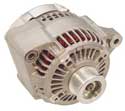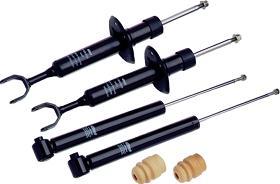ABS SERIES: Servicing the Bendix 9 Jeep ABS System

The Bendix 9 ABS system on 1989 to 1991 Jeep Cherokee and Wagoneer is an integral ABS system that combines the master brake cylinder with the hydraulic control modulator and two accumulators. The pump and motor are a separate assembly, but work with the master cylinder and hydraulic modulator assembly to provide power assist as well as anti-lock braking.
Bendix 9 is a four-wheel, three hydraulic channel ABS system. During normal braking, the vehicleís brake hydraulics are split diagonally. But during anti-lock braking, both front brakes are controlled separately, while the rear brakes are controlled as a pair. The modulator assembly contains nine solenoid valves: an isolation valve, a decay valve and a build valve for each of the three ABS circuits.
Four wheel-speed sensors (one for each wheel) are used. Front sensors are on the steering knuckles, with the sensor tone rings mounted on the axle shafts. Rear sensors are on the rear brake backing plates, with the sensor rings mounted on the axles.
The Bendix 9 system control module is under the back seat attached to the floorpan. On 1989 and 1990 models, the mounting angle of the module is important because the module contains a mercury switch that monitors vehicle deceleration. This allows the module to adjust anti-lock braking to better suit slippery driving conditions when the vehicle is being operated in four-wheel drive. If the module is removed or replaced, it must be reinstalled at exactly the same angle as before so the mercury switch will function correctly. On 1991 models, the module is mounted on a bracket that holds it at the proper angle.

PRESSURE SWITCHES & VALVES
The integral master cylinder, hydraulic control modulator and accumulator assembly contain a "boost pressure differential switch" mounted on the pressure modulator. It has a single terminal, is self-grounding and is normally open. This switch performs the same function as a differential pressure switch in a conventional brake system (it illuminates the BRAKE and ABS warning lights in the event of fluid loss from the brake system). The relays for both warning lights are located on the driverís side of the engine compartment near the master cylinder/modulator assembly.
The modulator assembly also has a brake proportioning valve and switch, and an accumulator low pressure switch for signaling the controller if accumulator pressure is lost. The accumulator switch is a single terminal, self-grounding switch that remains closed during normal operation. If pressure in the accumulator drops below 1,050 psi, the switch opens and the controller illuminates the yellow ABS light. If accumulator pressure does not increase enough to close the switch within 20 seconds, the red BRAKE warning light will also come on.
TWO ACCUMULATORS
Two accumulators are used: a high pressure accumulator (nitrogen precharged to 1,000 psi and capable of storing fluid at 1,700 to 2,000 psi) located on the master cylinder booster assembly, and a low-pressure accumulator (precharged to 350 psi, but also capable of storing fluid at 1,700 to 2,000 psi) which serves primarily as a fluid reservoir. Both accumulators work together to provide additional fluid pressure during anti-lock braking, as well as power-assisted brake applications should the booster pump and motor fail.
The remote pump and motor assembly are on the passenger side of the engine compartment. The pump supplies system pressure for normal power-assisted braking, as well as anti-lock braking. Power is supplied to the motor through a relay and pressure switch located next to the pump and motor assembly.
The pressure switch is designed to keep system operating pressure between 1,700 and 2,000 psi. When pressure drops below 1,700 psi, the switch closes and causes the pump to run until it builds up sufficient pressure to recharge the accumulators. At 2,000 psi, the switch opens and the pump shuts off. Normal pump time for a completely discharged system (zero psi) is about 60 to 80 seconds. The pump only runs when the ignition is on.
To protect the system from serious damage that would be caused by too much pressure, a pressure relief valve and thermal fuse are included as part of the motor and pump assembly. The pressure relief valve is a simple "blow off" valve that opens if pump pressure exceeds 3,000 psi. The relief valve does not reseat if it has been forced open, and must be replaced. The thermal fuse will shut the pump off if the pumpís operating temperature exceeds approximately 385 degrees.

SYSTEM OPERATION
The Bendix 9 Jeep ABS system has an unusual feature compared to other ABS systems in that it doesnít become functional until vehicle speed reaches 12 to 15 mph. It is also designed to disengage at speeds below 3 to 5 mph ó which may allow the wheels to chirp or skid slightly just before the vehicle comes to a complete stop when braking hard. This is a normal condition for this system and does not indicate a problem. It was designed to function this way to make it compatible with Jeepís Selec-Trac 4WD.
When the brakes are applied, the brake pedal switch signals the ABS module to compare the relative deceleration rates of all four wheels. If ABS braking is needed, the module energizes the appropriate ABS isolation solenoid to seal off the affected wheel brake. If either rear brake needs ABS braking, both lines are isolated simultaneously by a single solenoid.
Brake pressure in the isolated brake circuit(s) is then released by energizing the normally closed ABS decay solenoid. Pressure is reapplied by energizing the ABS build solenoid. This opens a passageway that allows pressure from the pump and accumulators to enter the line. Cycling of the decay and build solenoids will continue until the vehicle slows to 3 to 5 mph. At that point, the isolation solenoid is deenergized and anti-lock braking is discontinued. The wheels may then lockup or chirp slightly as the vehicle comes to a complete stop.
DIAGNOSTICS
The ABS control module monitors all system inputs while driving. If a fault is detected, the controller logs a fault code and illuminates one or both warning lights. The ABS warning light will remain on for the duration of the ignition cycle and as long as the fault is present. When the ABS warning light is on, the ABS system is deactivated, but normal braking is still available. If the red BRAKE warning light is also on, however, it signals loss of hydraulic pressure or power assist. The accumulators normally contain enough pressure for 15 to 20 power-assisted stops should the pump fail.
The Bendix 9 system does not provide manual flash codes, so a scan tool must be used to access fault codes. Codes on this system can be cleared by removing the ABS BAT fuse from the fuse panel for 10 seconds. A scan tool can also be used to perform a series of ABS electrical checks. If a failure or problem is detected during these tests, the scan tool will display a fault code indicating which circuit the problem is in. The scan tool can also be used to monitor various system inputs and outputs, including the wheel-speed sensors, the ABS solenoids and the operation of the pump motor.
FALSE CODES
One problem thatís common on Bendix 9 is false codes. The ABS controller can sometimes be fooled by certain driving conditions into believing a fault has occurred when in fact thereís nothing wrong with the system.
Spinning the wheels on ice, water, mud, snow or gravel, for example, when starting out in the two-wheel drive mode may cause the controller to think somethingís amiss with the wheel-speed sensors, causing the ABS warning light to come on and a code to be set. Deceleration on a steep incline or when the transfer case is in four-wheel low can sometimes set a brake code. A marginally low brake fluid level may trigger the red BRAKE warning light during hard deceleration or when driving on an incline. If the vehicle is driven over two to four miles per hour with the parking brake set, a fault code can be set. To rule out the possibility of a real problem, always perform a complete system check.
A different type of false code problem may be encountered on 1989-1990 Cherokees. The original ABS module (P/N 56004028) may have been replaced by a later 1991 module (P/N 56004948). The two modules appear to be identical, but communicate differently with a scan tool, resulting in false codes. The problem can be resolved by jumping terminals three and four on the D1 diagnostic connector. This reconfigures the data coming out of the newer module so the scan tool will read it correctly.

MAKING REPAIRS
The Bendix 9 system is an integral ABS system so the accumulators must be completely depressurized prior to doing any brake work. This can be done by pumping the brake pedal firmly at least 45 times while the ignition is in the off position.
Do not open any brake line unless this has been done!
The Bendix 9 system requires a special fluid fill procedure because both accumulators must be filled to get an accurate fluid level reading. The procedure goes as follows:
1. Fill the reservoir to the full mark;
2. Start the engine and pump the brakes until the booster pump/motor assembly turns on;
3. Stop pumping the brakes and wait for the pump to shut off; and
4. Recheck the fluid level and add as needed.
BLEEDING PROCEDURE
When bleeding the brakes either manually or with pressure bleeding equipment, the entire brake system must be bled, including the accumulators, pump and master cylinder as well as the individual brake lines. Depressurize the accumulator by pumping the brake pedal 25 to 40 times while the ignition is off, and leave the ignition off while bleeding the system.
The bleeding sequence for this system is right rear, left front, right front and left rear.





